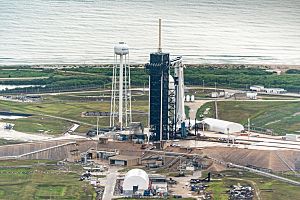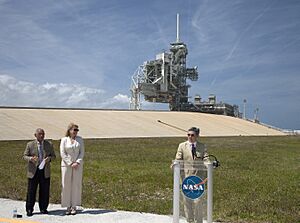Kennedy Space Center Launch Complex 39A facts for kids

Aerial view in May 2020, with Crew Dragon Endeavour atop a Falcon 9 with the pad's crew access arm extended.
|
|||||||||||||
| Launch site | Kennedy Space Center | ||||||||||||
|---|---|---|---|---|---|---|---|---|---|---|---|---|---|
| Location | Merritt Island, Florida | ||||||||||||
| Coordinates | 28°36′30.2″N 80°36′15.6″W / 28.608389°N 80.604333°W | ||||||||||||
| Operator | |||||||||||||
| Orbital inclination range |
28–62° | ||||||||||||
|
|||||||||||||
|
Launch Complex 39--Pad A
|
|||||||||||||
| Lua error in Module:Location_map at line 420: attempt to index field 'wikibase' (a nil value). | |||||||||||||
| Area | 160 acres (65 ha) | ||||||||||||
| Built | 1964–1968 | ||||||||||||
| MPS | John F. Kennedy Space Center MPS | ||||||||||||
| NRHP reference No. | 99001638 | ||||||||||||
| Added to NRHP | January 21, 2000 | ||||||||||||
Launch Complex 39A (LC-39A) is a very important launch pad at NASA's Kennedy Space Center in Merritt Island, Florida. It is one of two main launch pads there, along with Launch Complex 39B. This pad was first built for the giant Saturn V rocket, which was the most powerful rocket in the United States at the time.
LC-39A has been used for many historic human spaceflight missions since the late 1960s. Today, the pad is leased by SpaceX, a private space company. They have changed it to launch their own rockets, like the Falcon 9 and Falcon Heavy.
Contents
History of Launch Complex 39A
The Apollo Program
In 1961, President Kennedy set a big goal: to land a person on the Moon before the end of the decade. This led to the start of the Apollo program. NASA needed to grow a lot to achieve this. They expanded their launch operations to Merritt Island, next to Cape Canaveral.
Launch Complex 39A was designed to launch the huge Saturn V rocket. This rocket was powerful enough to send Apollo spacecraft all the way to the Moon. The very first launch from LC-39A happened in 1967. It was an uncrewed test flight called Apollo 4, carried by a Saturn V. The second uncrewed flight, Apollo 6, also launched from Pad 39A.
After these tests, Pad 39A became the main launch site for most crewed Apollo missions. This included Apollo 8, which was the first mission to orbit the Moon. All crewed Apollo-Saturn V launches used Pad 39A, except for Apollo 10.
The Space Shuttle Era
When the Space Shuttle program began in the early 1980s, the launch pads needed to be changed. The original structures were updated to fit the needs of the Space Shuttle.
The first time Pad 39A was used for the Space Shuttle was in 1979. The Space Shuttle Enterprise was used to check if the facilities were ready. After that, Pad 39A hosted all Space Shuttle launches until January 1986. That's when Challenger became the first shuttle to launch from Pad 39B during the sad STS-51-L mission.
During the launch of Discovery on STS-124 in 2008, Pad 39A was damaged. The concrete trench, which directs the rocket flames away, was badly hurt. Investigations showed that the damage was due to old materials and rust. The exhaust from the solid rocket boosters, which contains hydrochloric acid, made the damage worse.
Pad 39A supported the final Space Shuttle flights. This started with STS-117 in 2007 and ended with the retirement of the Shuttle fleet in July 2011. The pad stayed as it was after the last shuttle mission, STS-135, launched on July 8, 2011.
SpaceX Takes Over

In 2011, NASA started talking about letting private companies use the pad. By 2013, NASA announced they would allow commercial companies to lease LC-39A. Two companies wanted to use the launch complex. SpaceX wanted to use it only for their rockets. Jeff Bezos' company, Blue Origin, wanted to share the pad with other companies.
Blue Origin protested NASA's plan, saying SpaceX would get exclusive use. However, in December 2013, the protest was denied. NASA said their plan allowed for either shared or exclusive use.
On December 13, 2013, NASA chose SpaceX as the new company to use the pad. On April 14, 2014, SpaceX signed a 20-year agreement to use LC-39A. Elon Musk, the CEO of SpaceX, said he wanted to launch most of SpaceX's NASA missions from LC-39A. This included missions to send cargo and astronauts to the International Space Station.
Changes Made by SpaceX
In 2015, SpaceX built a new building called the Horizontal Integration Facility (HIF). This building is near the launch pad. It holds the Falcon 9 and Falcon Heavy rockets, along with their parts, before launch. These rockets are moved from the HIF to the launch pad on a special vehicle called a Transporter Erector. This vehicle travels on rails.
Also in 2015, SpaceX built a new launch mount on Pad 39A for the Falcon Heavy rocket. By late 2015, the HIF building and the pad changes were mostly finished.
In February 2016, SpaceX announced that Launch Complex 39A was ready for launches. However, more work was needed to support flights with astronauts. SpaceX had hoped to launch the Falcon Heavy from Pad 39A as early as 2015. But a Falcon 9 launch failure in June 2015 caused delays. SpaceX had to focus on fixing the Falcon 9 issues first. The Falcon Heavy's first launch was then moved to February 2018.
In 2019, SpaceX began major changes to LC-39A for their new, very large rocket called Starship. They are building a special launch stand for Starship prototypes. These prototypes will fly on short test flights. A second phase of construction is planned to build an even bigger launch mount. This will be able to launch the full Starship vehicle, which will be very powerful.
Recent Launches
The first SpaceX launch from Pad 39A was SpaceX CRS-10 on February 19, 2017. This mission used a Falcon 9 rocket to send cargo to the International Space Station. It was the first uncrewed launch from 39A since the Skylab missions.
While another SpaceX launch pad (SLC-40) was being repaired, all SpaceX launches from the East Coast used Pad 39A. This included the launch of NROL-76 in May 2017, which was a secret mission for the National Reconnaissance Office.
On February 6, 2018, Pad 39A hosted the first launch of the Falcon Heavy. This powerful rocket successfully lifted off, carrying Elon Musk's Tesla Roadster car into space. The first flight of the human-rated spacecraft Dragon 2 (called Crew Dragon Demo-1) also took place from Pad 39A on March 2, 2019.
The second Falcon Heavy flight was on April 11, 2019. It carried a communications satellite for Arabsat. This launch was special because SpaceX successfully landed all three reusable booster stages. These boosters can now be used again for future launches.
The Crew Dragon Demo-2 test flight launched from Launch Complex 39A on May 30, 2020. Astronauts Bob Behnken and Doug Hurley were on board. They successfully docked with the International Space Station the next day.
Launch Statistics
Lua error in Module:Chart at line 233: group 4 does not have same number of values as group 1.
Current Status of LC-39A
As of April 14, 2014, SpaceX has a 20-year agreement to use LC-39A. They launch their rockets from this pad and have built a new hangar nearby.
Elon Musk, the CEO of SpaceX, has said he wants to move most of SpaceX's NASA launches to LC-39A. This includes missions that carry cargo and astronauts to the International Space Station.
SpaceX uses the old Fixed Service Structure (FSS) of Pad 39A. They plan to make it taller than its original 350 feet (107 meters). SpaceX did not need the Rotating Service Structure (RSS), so they removed it starting in February 2016.
NASA removed the Orbiter Servicing Arm and the white room. The white room was where astronauts entered the Space Shuttle. SpaceX plans to add new levels to the FSS. This will allow astronauts to get into the Dragon 2 spacecraft for crewed flights.
SpaceX puts its rockets together horizontally in a hangar near the pad. Then, they move them horizontally to the pad and lift them upright for launch. For military missions, the payloads are put together vertically, as required by the USAF.
Pad 39A will be used to launch astronauts on the crewed version of the Dragon space capsule. This is part of a partnership with NASA. SpaceX plans to add a special arm and white room for astronauts to enter the spacecraft. The old Space Shuttle emergency escape system will also be reused. This system uses a slide-wire basket to help astronauts escape safely if there's an emergency on the pad.
In August 2018, SpaceX installed its Crew Access Arm (CAA). This arm is at the right height for astronauts to enter the Crew Dragon spacecraft on top of a Falcon 9 rocket. It looks a lot like the jetways you see at airports. In September 2018, the refurbished Space Shuttle Emergency Egress System was also moved to this new level.
In August 2019, SpaceX shared plans for the Starship launch system at Kennedy Space Center. These plans include building new structures at LC-39A just for Starship launches. This will include a special pad, tanks for liquid methane fuel, and a landing zone. These new structures are separate from the ones used for Falcon 9 and Falcon Heavy launches.
Gallery
-
Apollo 11 launch at LC-39A (1969)
-
Space Shuttle Enterprise at LC-39A during the fit check tests (1979)
-
Space Shuttle Atlantis at LC-39A (2007)
-
Falcon Heavy at LC-39A (2019)






